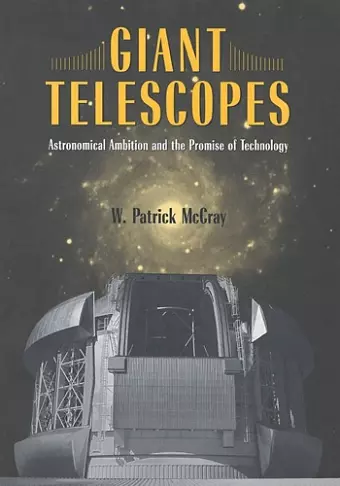Giant Telescopes
Astronomical Ambition and the Promise of Technology
Format:Paperback
Publisher:Harvard University Press
Published:30th May '06
Should be back in stock very soon

This vivid history of modern telescope building focuses on the turbulence, tension and triumph of building the Gemini 8-meter telescopes. Strong personalities, scientific opportunities, technological advances, and institutional rivalries are sharply etched and skillfully illuminated by McCray's deep reading of the record. As astronomers plunge headfirst into the next round of giant telescope building, this book should be on the required reading list. -- Robert P. Kirshner, author of The Extravagant Universe: Exploding Stars, Dark Energy, and the Accelerating Cosmos
By focusing on the history of the Gemini Observatory—twin 8-meter telescopes located on mountain peaks in Hawaii and Chile—Giant Telescopes tells the story behind the planning and construction of modern scientific tools, offering a detailed view of the technological and political transformation of astronomy in the postwar era.
Every night, astronomers use a new generation of giant telescopes at observatories around the world to study phenomena at the forefront of science. By focusing on the history of the Gemini Observatory—twin 8-meter telescopes located on mountain peaks in Hawaii and Chile—Giant Telescopes tells the story behind the planning and construction of modern scientific tools, offering a detailed view of the technological and political transformation of astronomy in the postwar era.
Drawing on interviews with participants and archival documents, W. Patrick McCray describes the ambitions and machinations of prominent astronomers, engineers, funding patrons, and politicians in their effort to construct a modern facility for cutting-edge science—and to establish a model for international cooperation in the coming era of “megascience.” His account details the technological, institutional, cultural, and financial challenges that scientists faced while planning and building a new generation of giant telescopes. Besides exploring how and why scientists embraced the promise and potential of new technologies, he considers how these new tools affected what it means to be an astronomer. McCray’s book should interest anyone who desires a deeper understanding of the science, technology, and politics behind finding our place in the universe.
In astronomy, phrases such as ‘thinking big’ don’t even begin to cover the situation. Fewer than 100 years ago, this galaxy was all there was but stargazers have pushed the universal population count to about 200bn galaxies so far—each with maybe 200bn stars—and extended the boundaries of the visible universe to about 13 bn light years. So a book about the academic bickering, muddled finance and international finesse behind the instruments that widened human horizons should be welcome. Even better, this heavenly topic has its share of drama and comedy. -- Tim Radford * The Guardian *
[An] insightful history of how ground-based telescopes have evolved and flourished over the past 50 years. [McCray’s] tale begins with the 200-inch Hale telescope at California’s Palomar Mountain, built in 1948, and ends with the twin 8-metre Gemini telescopes on mountains in Chile and Hawaii, completed in 2002. * New Scientist *
This is an exceptionally readable history of the 50-years-plus evolution of large ground-based telescopes from the era of ‘cowboy’ astronomers to the present day. Historian Patrick McCray shows how profound changes in the sociology of astronomy alternately drove or reflected the development of giant telescopes in the late 20th and early 21st centuries. -- Stephen P. Maran * Sky & Telescope *
Select illustrations, a helpful table of giant telescopes, notes, and a list of sources complete a well-written, authoritative, and important study. -- Joseph N. Tatarewicz * Technology and Culture *
This tale of the giant eyes on the sky that are revolutionising our knowledge of the universe reveals a fascinating piece of science policy and science history. -- Martin Ince * Times Higher Education Supplement *
This vivid history of modern telescope building focuses on the turbulence, tension, and triumph of building the Gemini 8-meter telescopes. Strong personalities, scientific opportunities, technological advances, and institutional rivalries are sharply etched and skillfully illuminated by McCray’s deep reading of the record. As astronomers plunge headfirst into the next round of giant telescope building, this book should be on the required reading list. -- Robert P. Kirshner, author of The Extravagant Universe: Exploding Stars, Dark Energy, and the Accelerating Cosmos
- Nominated for Pfizer Award 2004
- Nominated for Watson Davis and Helen Miles Davis Prize 2004
- Nominated for Sally Hacker Prize 2004
- Nominated for PROSE Awards 2003
- Nominated for Sidney Edelstein Prize 2004
ISBN: 9780674019966
Dimensions: 235mm x 156mm x 22mm
Weight: unknown
376 pages